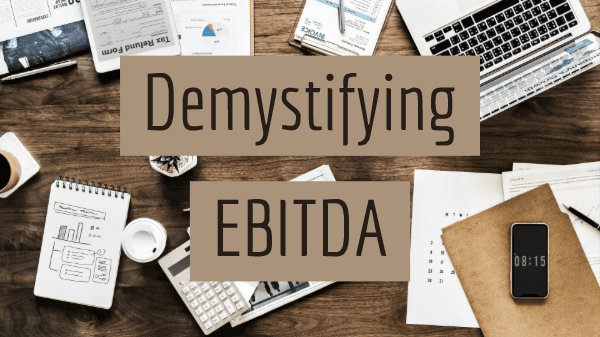To calculate EBITDA, take the sum of net income, interest expense, taxes, depreciation, and amortization.
Each line item in the EBITDA (earnings before interest, taxes, depreciation, and amortization) calculation is found on a company’s income statement, commonly referred to as a profit and loss statement.
Earnings is synonymous with net income/loss. This bottom-line value is also called “net profit” on some income statements. In its basic form, earnings represent total revenue minus total expenses. The calculation begins with earnings because it best approximates the cash thrown off by the operations of the business.
Interest is shorthand for interest expense. This includes any interest expense on debt that the company may have, including mortgages, lines of credit, credit cards, equipment loans, automobile loans, etc. Note that interest income earned by the company is not netted against the interest expense paid, as this would understate EBITDA.
Taxes represents both state and federal income taxes. Joe Braier, certified valuation analyst at Lakes Business Group in Waukesha, WI, notes “it is typical for these taxes to be listed on the profit and loss statement, often labeled as “Provisions for Income Taxes.” Payroll taxes, real estate taxes, and other local taxes are considered true operating expenses and should not be added back into the EBITDA calculation.
Depreciation refers to depreciation expense. This is added back because it is a noncash expense. When capital assets are purchased, their value as shown on the company’s balance sheet is depreciated (devalued) over time based on the standard ‘useful life’ of the type of capital asset.
For example, generally accepted accounting principles (or GAAP) dictate that the useful life of an automobile is 5 years. Therefore, on a straight-line depreciation schedule a $25,000 truck would incur $5,000 of depreciation expense on the income statement each year and a corresponding $5,000 increase in accumulated depreciation each year for the first five years after its purchase. This effectively reduces the carrying value of the asset, but is a noncash expense for the company, as the true cash expense was the initial $25,000 purchase of the truck in year one.
Amortization is amortization expense. This is added back because it is also a noncash expense that functions like depreciation. When ‘intangible’ assets are acquired (e.g., other companies, trademarks, customer lists, noncompete contracts, etc.), their value as shown on the company’s balance sheet is amortized (devalued) over time based on the type of intangible asset.
Flexibility and Adjustments
Though the EBITDA calculation is inflexible, many analysts and potential investors use an “adjusted EBITDA” calculation.
Bobbie Butler, MBA, a commercial lender with Hickory State Bank in Illinois, says that while EBITDA is helpful to determine if a company can repay its debt, “there could be nonrecurring items that should be factored into or out of EBITDA, which could result in an over- or understated amount.”
David Sneddon, assistant vice president of sponsor finance at BMO Harris Bank, agrees, noting these nonrecurring items should be added back into EBITDA “to capture the company’s true cash-generation potential.”
For example, a business founder may pay himself a $1 million salary when other CEOs earn only $500k. Conversely, a company could be paying its owners solely via distributions and no salary, in which case it would be prudent to deduct a fair salary from the EBITDA value.
Companies also experience true one-time expenses that can be added back to reach a “normalized” EBITDA level, including lawsuits, consulting fees, the cost of moving headquarters, etc. In the case of a higher-paid employee who is let go and not replaced, this salary could also be added back to reach an adjusted EBITDA value.
This is an excerpt from the most recent Produce Blueprints quarterly journal. Click here to read the full version.



